30. Recoil!
Accelerating a bullet from a stand-still to warp speed in a blink is not without cost. We feel it as recoil. Sir Isaac Newton described recoil when he figured out that for every action there must be an equal and opposite reaction. You can calculate recoil’s kinetic energy easily enough with this formula: KE = MV2 / GC, where M is the rifle’s mass and V its velocity. GC is a gravitational constant for earth: 64.32.
Now, mass and weight aren’t the same. Mass is the measure of an object’s inertia. The theory of relativity tells us that two objects have equal mass if the same force gives them equal acceleration. Using gravity as the force, we can equate mass with weight. That is, weight is a measure of the force by which gravity draws an object to earth. Because rifles respond pretty much the same to gravity, rifles of the same weight have essentially the same mass.
To get rifle velocity we must crunch some numbers. We already know most of them. The formula:
V = bullet weight (grs.) / 7000 x bullet velocity (fps) + powder weight (grs.) / 7000 x powder gas velocity (fps).
Powder and its gas figure in because like the bullet they are “ejecta” and contribute to recoil. You can get powder weight from factory rounds by pulling bullets and weighing charges. Gas velocity varies, but Art Alphin, in his A-Square handloading manual, claims that 5,200 fps is a useful average. The “7000” denominators simply convert grains to pounds so units make sense in the end.
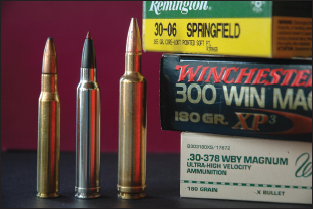
L-R: .30-60, .300 Winchester, .30-378 Weatherby. More powder extends reach – and hikes recoil!

Steve Kerby fires his Winchester 71 in .450 Alaskan, a cartridge with the muscle of the .450/400.
For a 180-grain bullet fired at 3,000 fps from my 8-½-lb .30-338, .300 Winchester or .308 Norma rifles, I’d calculate recoil this way: 180 / 7000 x 3000 + 70 / 7000 x 5200 = 8.5 x V. That simplifies to (77.143 + 52) 8.5 = V = 15.19 fps. Then I can calculate recoil using the first formula: KE = MV2 / GC. The result looks like this: 8.5 (15.19)2 / 64.32 = 30.49 ft-lbs of recoil.
Kinetic energy is not “kick.” What we feel as kick can vary significantly among rifles delivering the same amount of recoil in foot-pounds. There are a couple of reasons for this. One is that while bullet speed figures into the energy calculation, its contribution to rifle “slap,” or the blow of quick recoil, does not. A bullet that exits fast dumps all its energy fast too. The rifle seems to slap you instead of shoving you.
For example, a Ruger Number One launching a 405-grain .45-70 bullet at 1,800 fps (don’t try that load in your 1873 Springfield!) delivers about the same recoil force as a .338 Winchester Magnum thrusting a 225-grain spitzer at 2,800 fps. While you absorb about the same bundle of energy, the .338 may feel more brutal because the bullet and its reactive force leave the rifle more quickly.
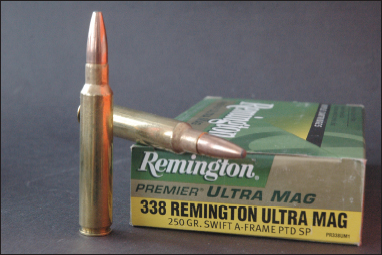
Similar to the .340 Weatherby, Remington’s .338 Ultra Mag kicks hard, requires long action.
Some shooters say rifles chambered for big-bore British cartridges merely push you, while sharp-shouldered magnums belt you, as if initiation by cordite somehow makes bullet launch more civil. I’m not convinced. There’s more than a push to a .600 Nitro in recoil! Even .470s light enough for safaris without gunbearers can get vicious. To add insult, the short breech section of a double puts the muzzles closer to your face, and those off-center bores cause the rifle to pivot. True, doubles have twice the barrel steel up front, and velocities and breech pressures are low. But bullets that weigh more than an ounce, in front of powder columns as long as a shotshell, ensure that you’ll get quite a jab. Inexperienced shooters or faulty locks that fire both barrels in quick succession make recoil more memorable. Also, there’s less fore-hand control with a double. While you can point surely and quickly, the double’s slender forend and slick barrels won’t match the checkered fore-stock of a bolt rifle for grip in absorbing recoil.
It does seem that sharp-shouldered magnum cartridges sometimes kick harder than they should. Combining heavy bullets with high pressures and big charges of powder behind abrupt shoulders makes rifles bounce violently. The .378 Weatherby Magnum and its progeny can bring on a flinch fast.
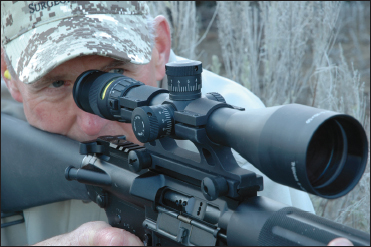
The .308 is versatile, in bolt guns or ARs. Here Wayne fires a Rock River LAR-8. Trijicon scope.

A long barrel and big brake distinguish this custom rifle by David Smith, here fired by Ken Nagel.
A muzzle brake reduces recoil by reducing jet effect at the muzzle. It bleeds gas pressure through vents instead of letting it erupt suddenly with explosive force. In siphoning the gas, a brake also provides opposing surfaces fore and aft of each vent for the gas to push against. So not all the thrust of escaping gas is rearward. Brakes boost muzzle blast. Noisy rifles are easy to shoot at the bench, where you can wear ear protection. But you won’t don muffs when you hunt. Shooting through a brake without them can ruin your hearing. Hunting guides, who often find themselves beside a hunter at the shot, by and large hate brakes.
A brake can also affect your shooting from low positions. Lying prone in dry dirt or snow, you’ll trigger a tornado that leaves residue on your scope lens and in your barrel, maybe in your eyes. At best, it will hang aloft long enough to obscure your view of the animal’s reaction. Without wind it can hang there after the animal and your chance for a second shot are gone.
Brakes needn’t be unsightly. Many are barrel-diameter, with unobtrusive vents. Lex Webernick, the Texas gun maker who operates under the Rifles, Inc. shingle, has studied brake design, even measured noise output with vents of various sizes and locations. His brakes are very trim, and so closely fitted as to be all but indistinguishable from the barrel. Winchester and Browning incorporated a brake into their BOSS (Ballistic Optimizing Shooting System) device. Apparently a lot of hunters are willing to take recoil over noise, because now the BOSS comes without vents. Anyone ordering a brake is wise to ask for a cap to protect barrel threads with the brake off. A Mark X Mauser in my rack, barreled by Intermountain Arms, has a brake installed only finger-tight. At the bench, this .338 is docile but noisy. I replace the brake with a cap for hunting. Not all barrels shoot to the same point of impact with and without a brake. This one does.

Chambered in .260 Remington, Sako’s handsome Grey Wolf is a versatile sporter with light recoil.
A long barrel reduces felt recoil, partly because it delays the jet effect of powder gas at the muzzle, partly because it thrusts the blast farther from you. It also adds weight to the rifle’s front end, counteracting muzzle jump—which means there’s less lift to slam the rifle into your chops.
Another thing that keeps recoil from hurting you is a well-designed stock. The comb should have just enough drop to put your eye behind the sight. It should be straight from front to rear (no more drop at the rearmost area of cheek contact). A well-rounded top mitigates the bite. Cast-off (the comb offset to the right) is typically an option only on custom rifles.
Early cartridge rifles from central Europe have “Tyrolean” cheekpieces with pronounced dishing. They’re comfortable if you’re shooting deliberately but awkward on the trail and ill-suited for quick shots from unorthodox positions. Combs that slope up at the rear (as on Weatherby Mark Vs) reduce the damage to my cheek. Proper stock pitch (angle of butt to bore) matters too. Not only does it help you aim quickly; it affects the muzzle’s arc at bullet exit. A soft butt-pad of generous dimensions slows and spreads recoil.
Shooting position and form affect felt recoil. When I was young I wondered why anyone would build a rifle with a crescent butt-plate. The butts of old lever rifles dug into my shoulder like bar-b-q forks when I aimed them at imaginary bears above the wood stove in the hardware store. I had fired a handful of carbines so equipped, and they all hurt me. What I learned later was that people who shot them in the days when crescent butts were in vogue placed the butts on their upper arms, not tight against their tender necks. They bent their heads over the stocks instead of relying on the comb for cheek support.

The .450 Bushmaster packs about as much punch into an AR-15 action as possible. It kicks hard.
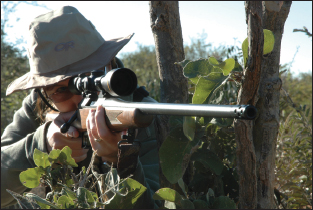
When you rest a rifle against a tree, pad it with your hand, or it will bounce from the hard surface.
Some rifles have a reputation for wicked kick. The Winchester 95 in .405 was one. Lots of power coupled with a low, sharp comb made this a molar-masher. Perhaps the most fearsome rifle in my rack is a Mauser in .458. Its stock is proportioned just right for the iron sights, and the rifle has the lively field of an upland bird gun. It doesn’t weigh much more. This .458 kicks as fast as lightning on skids. After three shots my head throbs. My jaw comes out of numb after the fourth. When the sights again settle on the target, I’d almost trade places with it. If this four-five-eight with the hooves of a mule didn’t point like a Rizzini and stick 500-grain solids into walnut-size groups, I’d trade it off.

You don’t need a hard-kicking cartridge to kill big animals. This Utah elk fell to Wayne’s .308.
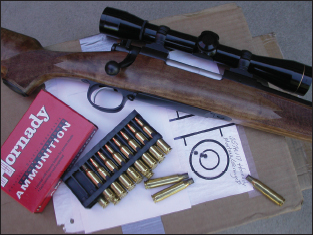
This Montana/Serengeti rifle in .257 Roberts is handsome, accurate, and a pleasure to shoot!
Brutal rifles give you little mercy at a bench. Leaning over a rifle on a table, you put your shoulder hard into the butt. The weight of your torso keeps you hard against it, so you absorb all the violence of a hard-kicking rifle. One way to make bench shooting more pleasant and keep flinching at bay is to use extra padding on your shoulder. In T-shirt weather folded bath towels work well because you can just drape them over your shoulder and shed them between strings. You’ll need a soft pad for your right elbow, too, or the bench top will skin it. An old sweatshirt works well here—better than small pads because you won’t tweak your position or put tension in your arm to keep it on the pad.
Recoil feels most severe when you’re prone, partly because your body has lots of ground contact and can’t move easily. That means you don’t act as a shock absorber to help the rifle decelerate; you stop it suddenly. Shooting uphill from prone can exacerbate the effects of recoil because it puts the scope closer to your noggin. A short stock and a scope set well to the rear give you an even chance of drawing more blood from your skull than from the animal.
You’ll absorb recoil most comfortably from offhand. Your body can flex and rock, damping the jolt. It’s good form to aim with your head erect and your eyes straight forward. You’ll get the clearest sight picture. But for shooters like me, with lots of neck between chin and shoulder, there’s a problem. We can’t get full shoulder contact with the butt while holding our head up and keeping our cheek in contact with the stock. So we move the butt up so only the toe bears on our shoulder. All the recoil lands on a tiny section of clavicle, bringing to mind that 5th-grade bully who used to zap us there with an electrical device that was once marketed as a toy but would now be classified as an assault weapon. Toe-only contact is still better than bending over the stock and squinting up to seek a patch of target and a hyphen of reticle.

Properly a bit front-heavy, and an armload even with open sights, this CZ in .505 Gibbs still kicks!
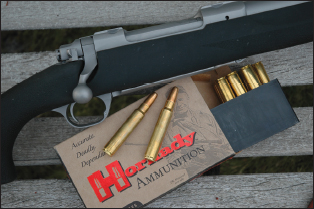
Ruger’s Alaskan in .375 Ruger is nicely balanced, quick to point, and handles recoil well.
Flinching is a real problem offhand because there’s no brace for your torso to counteract the tug of suddenly-tensed muscles. The crosswire gyrates wildly as you run short of breath trying to settle it. Your trigger finger tries in vain to time the shot. The sear is about to drop. Then you remember the jab you felt at this stage last time. Oh my, did that hurt! Yikes! It’s gonna git me again! Now! NOW!
On a recoil tolerance scale of gun-shy to Godzilla, I’m a notch above wimpish. My muscles are scattered in places that don’t arrest butt-pads. I’m painfully aware when I pull triggers that save for a slice of rubber, all that lies between my clavicle and an aspirin-bottle load of IMR 4350 are brass, steel, and hardwood. People make hammers and mallets out of that stuff. Pounding such objects into my body with charges of gunpowder makes as much sense to me as sitting on stumps over dynamite. On the other hand, I like to put holes in things far away, and shooting is the best way to do that. So I work at controlling those muscles that bunch when they sense I’m taking up the last ounce on a trigger.
Repeated flinching is flinching well-practiced—a routine you don’t want to learn.
Table of contents
- Title Page
- Dedication
- Copyright
- Acknowledgments
- Foreword
- CONTENTS
- INTRODUCTION
- SECTION I: BALLISTICS IN HISTORY
- SECTION II: THE MUSCLE BEHIND THE SHOT
- SECTION III: BULLETS—THE INSIDE STORY
- SECTION IV: SPEED, ENERGY, AND ARC
- SECTION V : PUTTING BALLISTICS TO WORK
- SECTION VI: FOR LONGER REACH
- BALLISTICS TABLES FOR MODERN SPORTING RIFLES
- GLOSSARY